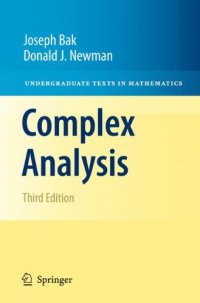
Ebook: Complex analysis
- Genre: Mathematics // Analysis
- Tags: Analysis
- Series: Undergraduate Texts in Mathematics 0
- Year: 2010
- Publisher: Springer-Verlag New York
- Edition: 3
- Language: English
- pdf
This unusual and lively textbook offers a clear and intuitive approach to the classical and beautiful theory of complex variables. With very little dependence on advanced concepts from several-variable calculus and topology, the text focuses on the authentic complex-variable ideas and techniques. Notable additions to "Complex Analysis, Third Edition," include: • The solution of the cubic equation and Newton’s method for approximating the zeroes of any polynomial; • Expanded treatments of the Schwarz reflection principle and of the mapping properties of analytic functions on closed domains; • An introduction to Schwarz-Christoffel transformations and to Dirichlet series; • A streamlined proof of the prime number theorem, and more. Accessible to students at their early stages of mathematical study, this full first year course in complex analysis offers new and interesting motivations for classical results and introduces related topics stressing motivation and technique. Numerous illustrations, examples, and now 300 exercises, enrich the text. Students who master this textbook will emerge with an excellent grounding in complex analysis, and a solid understanding of its wide applicability.
This unusual and lively textbook offers a clear and intuitive approach to the classical and beautiful theory of complex variables. With very little dependence on advanced concepts from several-variable calculus and topology, the text focuses on the authentic complex-variable ideas and techniques. Accessible to students at their early stages of mathematical study, this full first year course in complex analysis offers new and interesting motivations for classical results and introduces related topics stressing motivation and technique. Numerous illustrations, examples, and now 300 exercises, enrich the text. Students who master this textbook will emerge with an excellent grounding in complex analysis, and a solid understanding of its wide applicability.